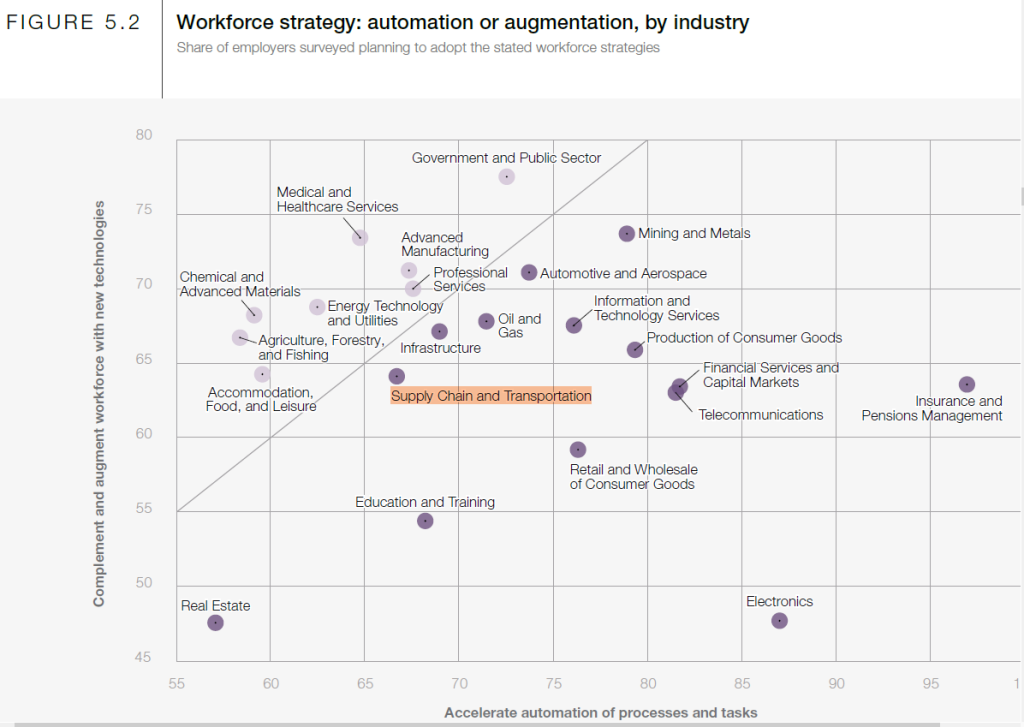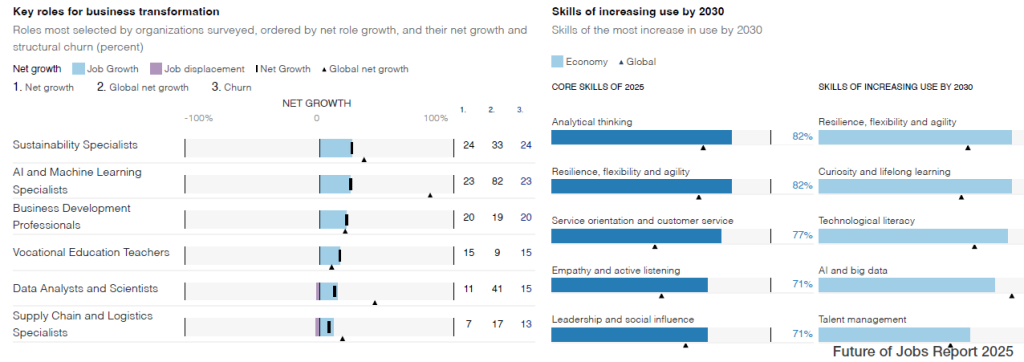Supply Chain & the WEF Future of Jobs 2025 Report: As outlined in the World Economic Forum’s (WEF) 2025 Future of Jobs Report, the global workforce is undergoing profound transformations, and the supply chain sector stands at a critical juncture, grappling with the disruptive forces of automation, artificial intelligence (AI), and evolving consumer demands.
The World Economic Forum’s (WEF) 2025 Future of Jobs Report serves as a pivotal roadmap for understanding the profound transformations reshaping the global workforce. Within this dynamic landscape, the supply chain sector stands at a critical juncture, grappling with the disruptive forces of automation, artificial intelligence (AI), and evolving consumer demands. This article delves deeper into the key implications of the WEF report for the Kenyan supply chain, analyzing emerging trends, examining critical challenges, and exploring strategies for navigating this complex and rapidly changing environment.
Supply Chain & the WEF Future of Jobs 2025 Report
1. The Rise of Automation and AI: Disrupting the Status Quo
The WEF report unequivocally emphasizes the accelerating pace of automation across industries.A net increase of 78 million jobs by 2030 and unprecedented demand for technology and GenAI skills
In the realm of supply chain, this translates to a significant shift in the nature of work.
Robotization and Automation:
- Warehouse Automation: Supply Chain & the WEF Future of Jobs 2025 Report also shows that warehouses are increasingly becoming hubs of robotic activity, with automated guided vehicles (AGVs), drones, and robotic arms streamlining tasks like order picking, packing, and sorting. This surge in automation promises to enhance efficiency, minimize human error, and increase productivity. However, it also raises concerns about job displacement for workers involved in these manual tasks.
- Autonomous Transportation: The rise of autonomous vehicles, including trucks and drones, holds the potential to revolutionize transportation and logistics. Self-driving trucks could optimize routes, reduce fuel consumption, and enhance safety. However, the widespread adoption of autonomous vehicles requires significant infrastructure development, regulatory frameworks, and careful consideration of the social and economic implications for the transportation workforce.
AI-Powered Decision Making:
- Predictive Analytics: AI algorithms are increasingly employed to analyze vast datasets, enabling businesses to anticipate demand fluctuations, optimize inventory levels, and identify potential disruptions in the supply chain. This predictive capability empowers businesses to make data-driven decisions, minimize risks, and improve overall agility.
- Supply Chain Visibility: AI-powered platforms can provide real-time visibility into every stage of the supply chain, from raw material sourcing to final delivery. This enhanced visibility enables businesses to identify bottlenecks, track shipments with greater accuracy, and proactively address potential challenges.
2. The Evolving Skill Landscape: Adapting to the Future of Work
The WEF report highlights the critical need for workers to acquire new skills and adapt to the changing demands of the job market. In the context of the Kenyan supply chain, this necessitates a focus on:
Digital Literacy and Technological Proficiency:
- Data Analytics: Proficiency in data analysis, interpretation, and visualization is crucial for understanding complex supply chain data and making informed decisions.
- Digital Platforms: Familiarity with cloud computing, supply chain management software, and other digital platforms is essential for navigating the interconnected global supply chain.
- Cybersecurity: With increasing reliance on technology, cybersecurity skills are paramount to protect sensitive data and safeguard the integrity of the supply chain.
Cognitive and Critical Thinking Skills:
- Problem-Solving: The ability to analyze complex challenges, identify root causes, and develop innovative solutions is highly valued.
- Decision-Making: Critical thinking skills are essential for making strategic decisions in a dynamic and uncertain environment.
- Creativity and Innovation: Fostering a culture of innovation and encouraging employees to explore new ideas and solutions is crucial for staying ahead of the curve.
Interpersonal and Communication Skills:
- Collaboration: Effective communication and collaboration are essential for navigating complex supply chains that involve multiple stakeholders, from suppliers and logistics providers to customers.
- Leadership and Teamwork: The ability to lead teams, build strong relationships, and foster a collaborative work environment is critical for success.
3. Emerging Roles and Career Pathways:
The evolving supply chain landscape is creating new and exciting career opportunities. Some of the most in-demand roles of the future include:
- Supply Chain Data Scientist: Analyzing vast datasets to identify trends, predict demand, and optimize operations.
- AI/ML Engineer: Developing and implementing AI-powered solutions for supply chain challenges, such as predictive maintenance, fraud detection, and demand forecasting.
- Blockchain Specialist: Leveraging blockchain technology to enhance transparency, traceability, and security within the supply chain, particularly for high-value goods and sensitive products.
- Sustainability Analyst: Evaluating and optimizing supply chains for environmental and social impact, ensuring sustainable sourcing practices and minimizing the environmental footprint.
- Supply Chain Robotics Engineer: Designing, programming, and maintaining robots and automated systems used in warehouses and logistics operations.
4. Navigating the Challenges: A Roadmap for Success
The transition to a more technology-driven and data-centric supply chain presents significant challenges. Key considerations include:
- Upskilling and Reskilling the Workforce: Investing in training programs to equip the current workforce with the necessary digital and technical skills is crucial. This may involve partnerships between industry, academia, and government to provide access to relevant training programs and certifications.
- Addressing the Digital Divide: Ensuring equitable access to technology, affordable internet connectivity, and digital literacy across all segments of the workforce is critical to avoid exacerbating existing inequalities.
- Fostering Innovation and Collaboration: Encouraging collaboration between businesses, academia, and government to drive innovation, develop new technologies, and address shared challenges.
- Prioritizing Ethical Considerations:
- Data Privacy and Security: Implementing robust cybersecurity measures to protect sensitive data and ensure compliance with data privacy regulations.
- Social and Environmental Impact: Ensuring that technological advancements are implemented in a socially and environmentally responsible manner, minimizing the environmental footprint and ensuring fair labor practices throughout the supply chain.
- Addressing Job Displacement: Implementing strategies to mitigate the potential impact of automation on employment, such as providing retraining programs and supporting the transition to new roles.
Building a Resilient and Sustainable Supply Chain:
- Risk Management: Developing robust risk management strategies to mitigate the impact of unforeseen events, such as natural disasters, pandemics, and geopolitical instability.
- Sustainability: Integrating sustainability principles throughout the entire supply chain, from sourcing raw materials to final delivery, to minimize environmental impact and promote ethical and responsible business practices.
5. The Kenyan Context: Opportunities and Challenges
The Kenyan supply chain sector presents a unique set of opportunities and challenges:
- Leveraging Technology for Growth: Kenya has the potential to leverage technology to leapfrog traditional development models and build a modern, efficient, and competitive supply chain.
- Developing a Skilled Workforce: Investing in education and training programs to equip the Kenyan workforce with the skills necessary to thrive in the digital age is crucial.
- Promoting Innovation and Entrepreneurship: Fostering a culture of innovation and entrepreneurship within the Kenyan supply chain sector, encouraging the development of new technologies and business models.
- Addressing Infrastructure Challenges: Investing in infrastructure development, including roads, railways, and ports, is essential for improving connectivity and facilitating the efficient movement of goods.
6. Conclusion
The WEF 2025 report serves as a crucial wake-up call for the supply chain industry. By embracing technological advancements, developing the necessary skills, and addressing the challenges proactively, Kenyan businesses can navigate this evolving landscape and build a more resilient, efficient, and sustainable future for their supply chains. This will not only enhance competitiveness and drive economic growth but also contribute to a more inclusive and equitable society.
Further Considerations:
- Government Policy: The role of government policy in supporting the development of a modern and competitive supply chain sector is critical. This includes creating an enabling environment for innovation, investing in infrastructure, and providing incentives for businesses to adopt new technologies.
- International Collaboration: Collaborating with international partners to share best practices, exchange knowledge, and develop joint solutions to global supply chain challenges.
- Continuous Learning and Adaptation: The supply chain landscape is constantly evolving. Businesses and individuals must embrace a culture of continuous learning and adaptation to stay ahead of the curve and remain competitive.
Disclaimer: This article is based on the WEF 2025 report and provides a general overview. The actual impact of these trends may vary depending on specific industry sectors and regional contexts.
- Data Privacy and Security: Implementing robust cybersecurity measures to protect sensitive data and ensure compliance with data privacy regulations.
Interesting Numbers
- Half of employers plan to re-orient their business in response to AI
- 80% plan to upskill workers with AI training and two-thirds plan to hire talent with specific AI skills, while only 40% plan to reduce their workforce as AI automates certain tasks.
- 85% of employers plan to upskill their workforce in response to growing skills gaps – with half of businesses planning to transition staff into growing roles.
- 73% plan to automate more processes
- 70% plan to hire talent with new skills



